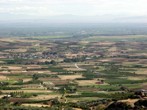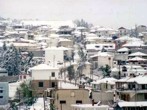|
|
| Location |
The archaeological site of Paliambela Kolindros is situated in north-eastern Pieria, a municipality of 352 square kilometres that belongs to the wider region of central Macedonia. Paliambela is located on the low hills that lie between the foot of the mountains of Pieria to the south and the large plain of Yiannitsa to the north. It is just a short distance from the shores of the Thermaic Gulf to the east, and the same distance from the Aliakmonas River to the north. |
| |
| Environment |
 The Paliambela area is rich in both flora and fauna. In the plain surrounding the village thrive many fruit-bearing trees and there is an abundance of broad-leafed evergreens, such as oak, chestnut and arbutus trees. Higher up, at the foot of the Pieria mountains, one finds forests with oak, beech, chestnut, pine and fir trees, which are visible from the village itself. Given the proximity of the Aliakmonas delta, there is a significant concentration of reptiles, amphibians, birds and mammals. A number of bird species, such as ducks and storks, exploit the area either to nest and spend the winter or to rest during their long migratory journeys. This results in the impressive sight of numerous nests on the telegraph poles and the roofs both in Paliambela, and moreover in the neighbouring town of Eginio. The Paliambela area is rich in both flora and fauna. In the plain surrounding the village thrive many fruit-bearing trees and there is an abundance of broad-leafed evergreens, such as oak, chestnut and arbutus trees. Higher up, at the foot of the Pieria mountains, one finds forests with oak, beech, chestnut, pine and fir trees, which are visible from the village itself. Given the proximity of the Aliakmonas delta, there is a significant concentration of reptiles, amphibians, birds and mammals. A number of bird species, such as ducks and storks, exploit the area either to nest and spend the winter or to rest during their long migratory journeys. This results in the impressive sight of numerous nests on the telegraph poles and the roofs both in Paliambela, and moreover in the neighbouring town of Eginio. |
| |
| Geology |
The geological studies of the area show that a large part of the wider plain (the Yiannista plain) to the north and east were once covered by the sea, which once reached almost to the town of Veria in the north-east (6th century BC). The gradual joining of the major rivers with the Thermaic Gulf, particularly the Aliakmonas River, created an  alluvial delta which led to the formation of the fertile plain in the area. Paliambela does not seem to have been directly affected by these events however, as the area preserves formations of the Neogene period in the form of marl, sandstone and argilaceous rocks in many places, even on and around the mound of the settlement. alluvial delta which led to the formation of the fertile plain in the area. Paliambela does not seem to have been directly affected by these events however, as the area preserves formations of the Neogene period in the form of marl, sandstone and argilaceous rocks in many places, even on and around the mound of the settlement. |
| |
| Climate |
 The region's climate is typically Mediterranean, that is to say warm and dry in summer, and cold and wet in winter. The rainiest months of the year are December and January, while the driest is July. In winter the prevailing winds are northerly (the Vardaris), while in summer the southerly sea winds ward off particularly dry conditions. Finally, snowfall is not a significant factor and is limited to the mountain areas of Pieria and Olympus. The region's climate is typically Mediterranean, that is to say warm and dry in summer, and cold and wet in winter. The rainiest months of the year are December and January, while the driest is July. In winter the prevailing winds are northerly (the Vardaris), while in summer the southerly sea winds ward off particularly dry conditions. Finally, snowfall is not a significant factor and is limited to the mountain areas of Pieria and Olympus. |
|
|





